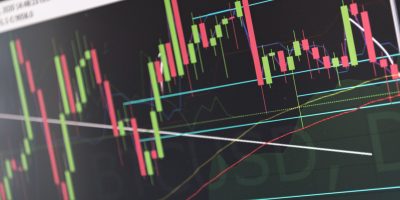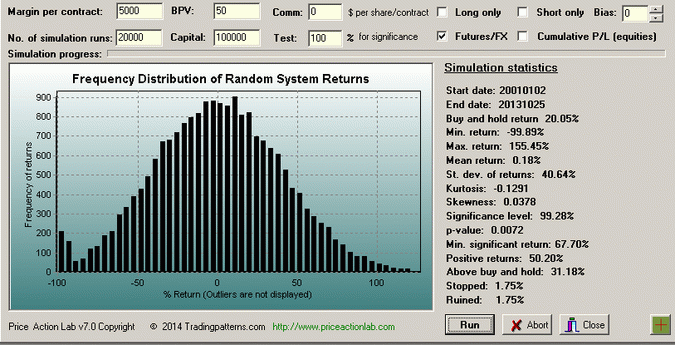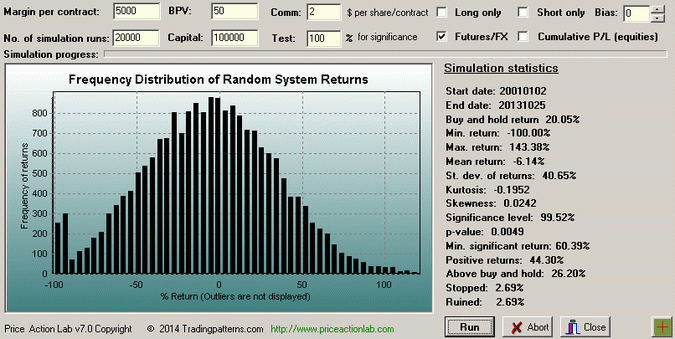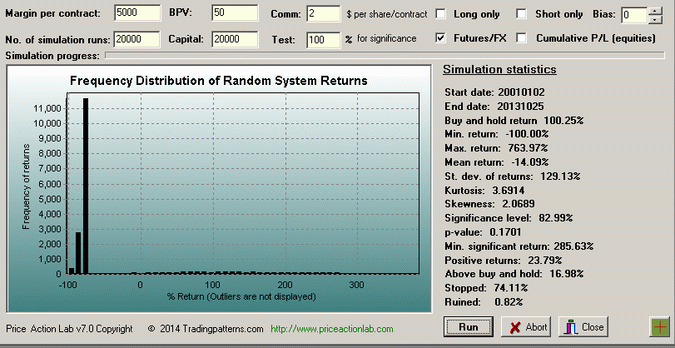This is the second part of a four part series on the perils of day and position trading in futures and forex markets. In this part, the results of a simulation of a large number of random trading systems in E-mini S&P 500 futures confirm the empirical fact that only a small percentage of position traders are profitable.
In Part One, I presented the results of a simulation of a large number of random E-mini S&P 500 futures day trading systems that confirmed the empirical fact that only a very small percentage of day traders in that market are profitable. The analysis in this post deals with position trading in the same contract.
Position trading is a popular style that is usually based on daily OHLC bars. Position trades may last several days and they are impacted by overnight gap risk. Although noise is lower in daily timeframes than in intraday, it turns out that transaction cost and overnight gap risk greatly impact the profitability of position traders and they have not much better chances to succeed than their intraday counterparts.
A sample of 3228 bars of the E-mini S&P 500 futures in the period 01/02/2001 to 10/25/2013 was used in the following simulation:
1) A fair coin is tossed before the close of the first bar of the data sample. If heads shows up, then any open short position is closed and one futures contract is bought at the close. Any open long position is closed and one contract is sold short when tails show up. This is repeated until the end of the sample and then the net return of the resulting sequence of entry and exit points (system) is calculated. A random system is stopped if its initial equity is reduced below the required margin. Ruin occurs when equity drops close to zero.
2) The simulation in (1) is repeated 20,000 times.
3) A distribution of the 20,000 net return values is plotted and several statistics are calculated.
An initial margin of $5,000 was used in all simulations.
Case 1: Initial capital: $100,000, Commission each way: $0
Below is the distribution of the net returns of the 20,000 random entry and exit sequences generated by tossing the fair coin:
The above distribution confirms the zero-sum nature of futures trading: 50.20% of random systems, i.e., nearly half of them, were profitable with a mean return of 0.10%. The distribution is close to normal with a small kurtosis and skewness. Only 1.75% of the systems were stopped or ruined. The lowest return was about -100% and the highest was +155.45%.The buy and hold return was 20.05% in the simulation period and 31.18% of the random systems exceeded that. A 100% test return was better than the return of 99.28% of the random systems, resulting in a p-value of 0.0072.
Case 2: Initial capital: $100,000, Commission each way: $2
Next, we apply $2 commission each way to all trades and repeat the simulation for the same initial capital of $100,000. Below is the new distribution of the net returns:
The introduction of the small commission charge affected the number of profitable trading systems, as was expected. The percentage of profitable random systems fell from close to 50% when no commission was included to 44.30% with the $2 charge each way. The percentage of stopped or ruined systems also increased to 2.69%.
Note that the majority of position traders do not trade one E-mini S&P 500 futures contract per $100,000 of available equity. The large starting capital in the first two cases was used to demonstrate the zero-sum nature of trading futures contracts and how it is affected by a small commission charge. Cases 3 and 4 reflect more realistic starting capital levels of $20,000 and $10,000, in the case of retail traders.
Case 3: Initial capital: $20,000, Commission each way: $2
Next, we lower the initial capital to $20,000. Commission remains at $2 each way. Below is the new distribution of the net return of the 20,000 random systems:
Due to the spike at the left, denoting the large percentage of stopped systems, the distribution is barely visible but it has mean return of -14.09%. With $20,000 initial capital, 74.11% of the random systems are stopped (equity drops below margin) and 0.82% of them are ruined (-100% loss). About 24% of the random systems are profitable. These results demonstrate the impact of lower capitalization on profitability in zero-sum trading markets that turn to negative-sum when transaction costs is included.
Case 4: Initial capital: $10,000, Commission each way: $2
Next, we lower the initial capital to $10,000. Commission remains at $2 each way. Below is the new distribution of the net return of the 20,000 random systems:
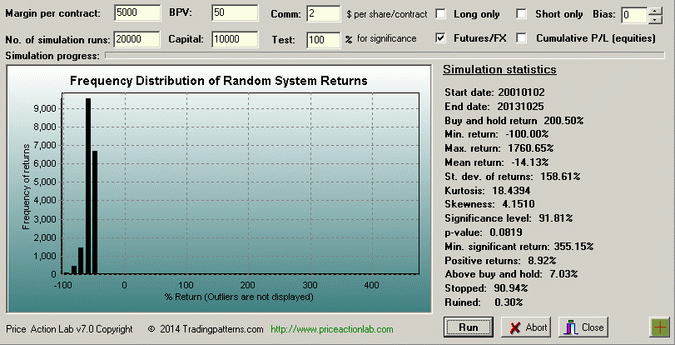
Discussion of the results of this study
It is expected that the following objections may be raised regarding the interpretation of the results of this study.
1. The simulation was based on random system but my system is not random
Answer: In logic, if one claims that unicorns exist, the burden of proof is on him and not on those who object. Similarly, if someone claims to have an edge in trading, the burden of proof is on him to prove it. However, that may not be possible, as in the case of unicorns. Notice how in the last simulation the highest return was 1,760% due to the large leverage resulting from the lower initial capital. Because of leverage, high returns cannot be used for proving an edge, unless they are properly adjusted for risk. In other words, profitability is not an edge because it may be the result of luck. An “edge” is something else but to claim one, one must first prove that edges exist in general. This is a complicated problem and, possibly, it has no solution.
2. A coin toss is not a trading system. I trade with the XYZ indicator
Answer: Whether you toss a coin or you use an indicator, performance is calculated based on entry and exit signals. When looking at sequences of entry and exit signals, they all look similar regardless of the method used to generate them. More importantly, one or even some of the random sequences may look quite similar to those generated by some indicators or group of indicators. Even more importantly, one must prove that the indicator used is better than a coin toss system and that may be difficult to do in most cases. There are indicators that have predictive ability for position trading but that must be proven using proper statistical analysis. Suffice to say that most known technical analysis indicators generate random signals.
3. If futures position trading is a negative-sum game, why is it so popular?
Answer: This happens because 99% of the trading literature involves unsupported claims of trading success and trading gurus would have no subject if they admitted the truth about the low success rate.
4. Where do some pros get their edge from?
Answer: Pros profit either from making markets or from the presence of a large number of unskilled and uninformed traders. Pros like to see more of those trading books for the masses based on unsupported claims of success that lure more potential losers to the markets.
Part three in this series will be about daily forex trading. An analysis of position forex trading will follow. So stay tuned!
You can subscribe here to notifications of new posts by email.
© 2015 Michael Harris. All Rights Reserved. We grant a revocable permission to create a hyperlink to this blog subject to certain terms and conditions. Any unauthorized copy, reproduction, distribution, publication, display, modification, or transmission of any part of this blog is strictly prohibited without prior written permission.
